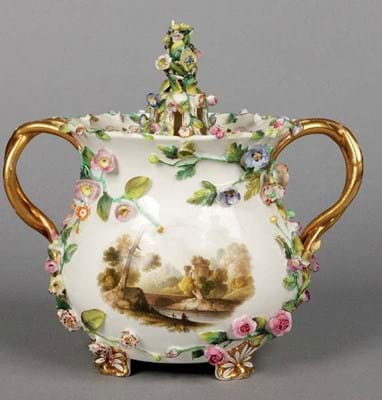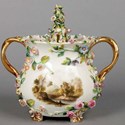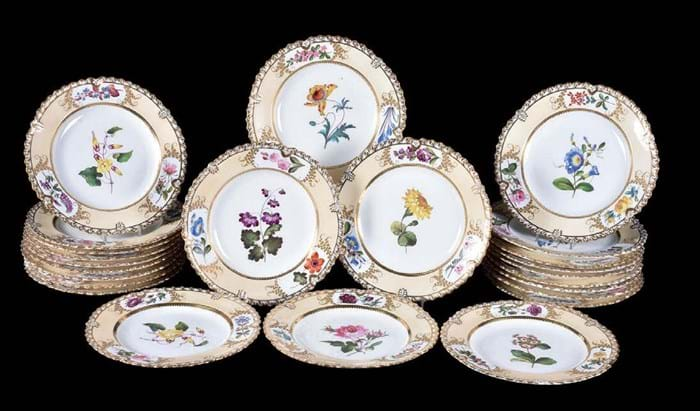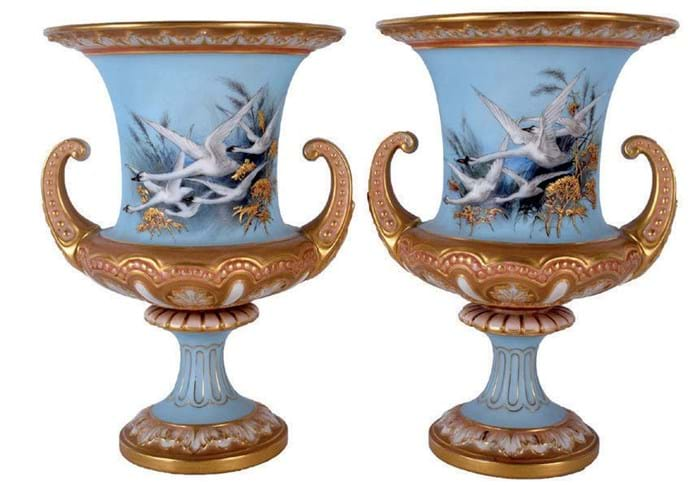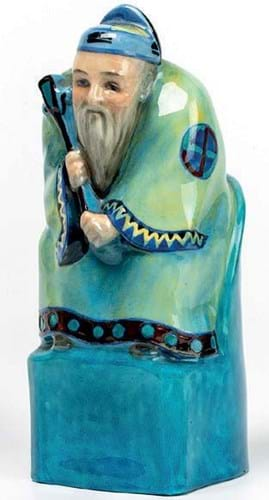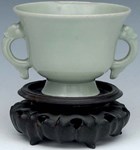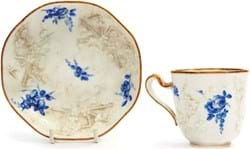The decline in prices for so much 19th century English porcelain has hit Rockingham as much as any – but auctioneer Jody Beighton of South Yorkshire firm Paul Beighton (17.5% buyer’s premium) is one of the many who can look on the bright side.
He is a keen collector of the local porcelain and says: “It’s a good time to be buying.”
The first tranche of the Rowley collection of Rockingham porcelain, amassed by a local couple, was offered in the Thurcroft saleroom on November 25.
All 40 pieces in the sale got away at around, or above, estimates and totalled just short of £10,000 – a solid result in an ‘unfashionable’ collecting area.
“We have a top estimate of £20,000 for the whole 120-lot collection, so we’re well on course,” said Beighton, who will offer the 80 other pieces in March and May.
Stately preview
In the run-up to the sale, Beighton had displayed the collection in its entirety at nearby stately Wentworth Woodhouse, home of the heirs of Earl Fitzwilliam. In c.1826 the earl had loaned money to his local pottery to fund production of soft-paste porcelain which bore the Rockingham family’s griffin crest.
The aristocratic patronage led to royal commissions and worldwide fame for the factory’s flamboyant material, although when in 1841 the earl’s successor withdrew support the factory quickly closed.
Rockingham still has a strong regional following – Carol Rowley and husband began by collecting pieces decorated with local scenes – and Beighton hopes such local links might inspire a new generation to take an interest.
The display at Wentworth Woodhouse did find admirers outside the core collecting community.
“There were a lot of younger people visiting the house and many of them were looking at the lots. They notice it is affordable and, like me, younger people don’t remember the boom years,” said Beighton. “Now we just have to get them in the saleroom buying.”
At a base level, a c.1830-42, 5¾in (14.5cm) tall pot-pourri basket and stand lacking its cover and with restored handle took a mid-estimate £50 from one of the private buyers who comprehensively saw off trade competition at the sale.
Top-seller was a pair of c.1826-30 dessert plates bearing the red griffin mark. With gilt rims, primrose-leaf moulded borders and enamelled with flowers painted by Edwin Steele, the 9½in (24.5cm) diameter plates more than doubled the top estimate at £1100.
Other items to double expectations included a 1830-42, 10½in (27cm) tall, bulbous pot-pourri vase and cover, and a 4½in (11.25cm) tall c.1830-42 spill vase, both bearing the puce griffin mark.
The pot-pourri vase, enamelled with a titled Cumbrian river scene and solitary angler to one side and with fruit and flowers to the other, took £800. The cylindrical spill vase on spreading foot and featuring an enamelled continuing landscape of a folly and boats on a lake, had a crack but took £500.
Coalport Union
From much the same period, a Coalport botanical Union part dessert service performed well at Dreweatts (25% buyer’s premium) in Newbury on November 20.
Made in the Rococo revival style c.1825, the pattern name refers to the rose, thistle and shamrock emblems, supposedly celebrating the Act of Union that came into effect in 1801.
The lot comprised 24 plates plus four shell dishes, four lozenge-shaped serving dishes, a pair of shaped square plates and a 15in (38cm) comport.
“It was in good commercial condition and services with well-painted botanical sprays are always popular,” said Dreweatts ceramics specialist Geoffrey Stafford Charles.
“It had the so-called Union border and the principal pieces had very nice handles, also modelled with with roses, thistles, shamrocks and crowns.”
Pitched at £1000-1500, the service sold to an American bidder on thesaleroom.com at £4200.
Limehouse sauceboat
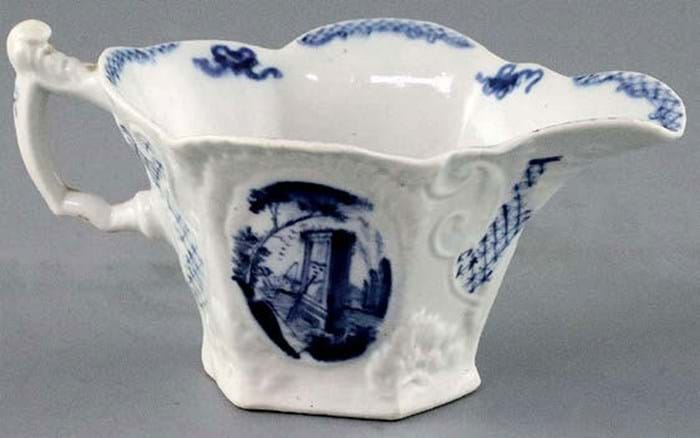
Limehouse cream jug – £3000 at Gorringe’s.
Typically appealing to a different collecting audience are the productions of the pioneering Limehouse factory, the first English producer of soft-paste porcelain.
This short-lived concern, operative only from 1745-48, was given its name after excavations on the east London site in 1990.
Gorringe’s (21% buyer’s premium) sale in Lewes on December 3 – a catalogue that included a Daoguang mark and period vase that sold at £270,000 (see last week’s News pages) – included a 5½in (14cm) wide hexagonal cream boat with a Limehouse attribution.
It had oval cartouches painted with a classical monument under a tree and a house and took £3000, the lower estimate.
The best piece of early Worcester proved to be an octagonal c.1753, coffee cup that, at 2½in (6.5cm) tall, was unsually large and was enamelled with a Chinese figure and chinoiserie flowers. It sold at £1700.
Baldwyn vases
No decorator from the Royal Worcester period of production is better known than Charles Baldwyn (1843-1913).
He famously started at the factory at the age of 15 learning to paint the vignettes of animals and birds, particularly swans, that became a favourite of the public.
They still are – as evidenced at Hannam’s (23% buyer’s premium) November 11 sale at Selborne in Hampshire where a pair of 8in (20cm) twin-handled urn vases decorated with swans in flight was a private buy at £4000.
Sherratt group
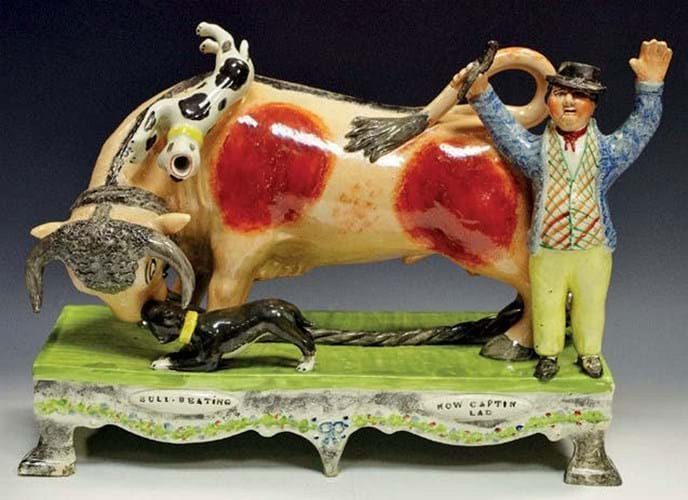
Sherratt-style bull-baiting group – £3000 at Bamfords.
Most of the Staffordshire figures sold at Derbyshire auction house Bamfords (21% buyer’s premium) on November 20 sold as expected at two-figure sums but a couple of exceptions emerged. Both had serious condition problems, including breaks and poor old repairs, but are well-known models from c.1800.
Obadiah Sherratt was probably the maker of a 13in (33cm) wide group depicting tethered bull attacked by two dogs beside a man on a rectangular table base, inscribed Bull Beating, Now Captin Lad.
A 6½in (17cm) wide pearlware figure group of Saboyard was modelled with dancing bear and a miniature lion.
Two collectors competed for the figures and one succeeded in buying both, bidding £3000 for the bull and £1800 for the bear.
Doulton Mandarin
One of the rarest of all Royal Doulton HN series figures emerged for sale at Hartleys (17.5% buyer’s premium) in Ilkley on November 27.
The 7¾in (19.5cm) tall Mandarin (marked HN366) was designed by Charles Noke and in production from 1920-38.
Proof that the best Doulton pieces remain in demand, it was pitched at £500-800 but sold at £6600.



